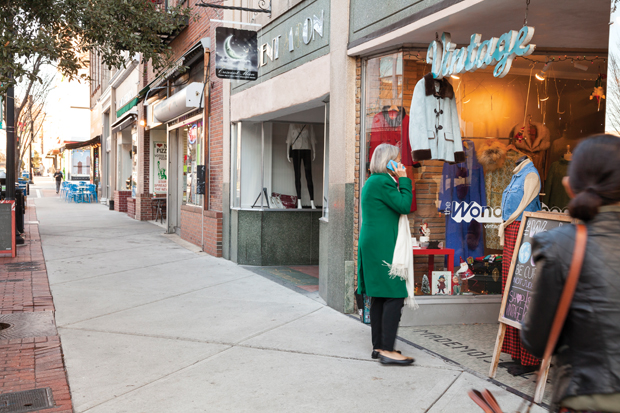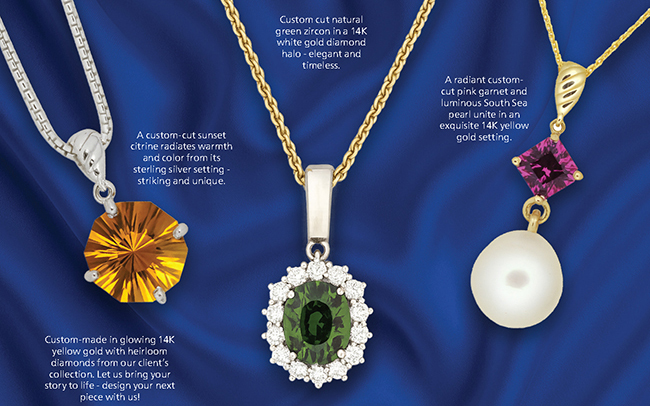Heart to Heart
03 Jan 2018
Valentine’s Day facts, figures, trends, and ways to say, “I love you”
By CAROLINE GOBBLE
Photos by KELLY STARBUCK PHOTOGRAPHY

The great American cartoonist, Charles M. Shultz, once said, “All you need is love. But, a little chocolate now and then doesn’t hurt.” According to History.com, most Americans agree, especially around Valentine’s Day, as approximately 58 million pounds of chocolate candy and 36 million heart-shaped boxes of chocolate are bought during the week of this romantic holiday and celebration of love.
From cards and flowers to jewelry and sweet treats, Valentine’s Day has become the second most-popular day for exchanging greeting cards (after Christmas). As Fortune Magazine writes, “The U.S. economy loves Valentine’s Day. A new survey from the National Retail Federation (NRF) projects U.S. consumers will spend a total of $18.2 billion on their valentines this year. Over $4 billion of that will be spent on jewelry alone, with another $2 billion on flowers. Consumers are also expected to spend on cards, clothes, and an overall nice evening out on February 14th.” Since 2004, the NRF has been conducting an annual Valentine’s Day consumer spending survey to better understand if and how Americans will celebrate the holiday, as well as to project how consumer spending will affect the economy.
So, what is the origin of Valentine’s Day and the reason we still give gifts and cards to our loved ones on February 14th each year? The answer is not that simple as multiple theories abound. According to History.com, Valentine was a priest who defied Emperor Claudius II by performing marriages in secret after the Emperor outlawed them.
Hallmark research surrounding one legend explains, “According to Roman legend, during the third century, Valentinus was imprisoned for his Christian beliefs and sentenced to death. While jailed, Valentinus restored the sight of his jailer’s blind daughter. The night before he died, Valentinus wrote a farewell note to the girl, which he signed, ‘From Your Valentine.’ His sentence was carried out the next day, February 14, 269 A.D.” He was imprisoned for helping Christians escape from Roman prisons, which were often fraught with torture. By the Middle Ages, his reputation of being a hero and romantic figure led to his popularity in England and France.
Another suggestion from History.com as to why Valentine’s Day occurs in the middle of February is that the Christian Church wanted to de-secularize the pagan celebration of Lupercalia. “Celebrated at the ides of February, or February 15, Lupercalia was a fertility festival dedicated to Fanus, the Roman god of agriculture, as well as to the Roman founders Romulus and Remus,” says History.com. The festival often led to matchmaking and eventually marriage for many young men and women. Lupercalia was outlawed at the end of the 5th century, and Pope Gelasius declared February 14th Valentine’s Day.
The holiday did not become associated with love and romance, however, until the Middle Ages when Europeans believed it marked the beginning of the mating season for birds. It was also during the Middle Ages when Valentine’s Day greetings became popular. As History.com cites, “the oldest known valentine still in existence today was a poem written in 1415 by Charles, Duke of Orleans, to his wife while he was imprisoned in the Tower of London following his capture at the Battle of Agincourt.” The note is now a part of the British Library’s manuscript collection in London, England.
In America, people started making and exchanging Valentine’s in the 18th century, and, according to Hallmark, Esther Howland of Worcester, Massachusetts, began selling hand-made Valentine’s. She is now known as the “Mother of the Valentine.”
Today, approximately 180 million Valentines are exchanged each year according to the Statistic Brain Research Institute. Hallmark cites that over 50% of these cards are purchased in the six days prior to the holiday, and women purchase 85% of all valentines, according to History.com. Men, however, purchase 73% of flowers on Valentine’s Day. The Statistic Brain Research Institute says that an average of 198,000,000 roses are produced for Valentine’s Day, and flowers are the second most popular gift given on the special day, while candy reigns the most common gift given.
ProFlowers.com explains, “for thousands of years, the middle of February has been a time for fertility festival celebrations, so it is no wonder Valentine’s Day flowers are often the gift of choice. For centuries, flowers have symbolized fertility, love, marriage, and romance.” For centuries, flower bouquets have been a way to send along non-verbal messages. This custom dates back to the 18th century when, according to Teleflora, “Charles II introduced the Persian language of flowers to Europe in the 1700s and has continued throughout the years as a means for expressing love and appreciation on the holiday.” The language of flowers, or floriography, is rooted in England’s Victorian era and assigns symbols and meanings to flowers.
So, what are some of the most popular or most appropriate flowers to buy and send on Valentine’s Day as a symbol of love? The red rose is by far the best seller, and it is a symbol of love, romance, passion, and beauty. Teleflora.com explains, “Red isn’t the only option, either, if you think a different hue would suit your sweetheart. There are actually more than 150 varieties of roses, meaning there’s bound to be an option that would fit your valentine perfectly.” Roses, however, can be pricey.
A more affordable option is carnations, which fall right behind roses in popularity. “Carnations have been linked with fascination, making them a great pick for a relationship in its early stages. Plus, there are a multitude of different colors to choose from, so you can certainly find one that will match your valentine’s style and personality,” explains Telefora.com.
In a Woman’s’ Day interview, Michael Gaffney, Director of the New York School of Flower Design, says, "Tulips stand for perfect love." According to the Victorian language of flowers, red tulips are a declaration of love, and thus, a perfect Valentine’s Day gift. They are also very affordable, come in a variety of colors, and last longer than many other vase flowers.
What would Valentine’s Day be without chocolate? Popularly accepted to be an aphrodisiac, chocolate (and candy) ranks as the number one most commonly given gift at Valentine’s Day. As the Victorian era saw the rise of Valentine’s cards and the language of flowers, it also was the time of Richard Cadbury’s rise to fame with his British chocolate manufacturing family. According to History.com, the company sold chocolates in beautifully decorated boxes which were useful even after all of the chocolate was gone.
And lastly, many consumers find that loved ones deserve sparkle and shine for Valentine’s Day, and jewelry ranks as the fourth most given gift on February 14th. According to NRF’s 2017 survey, “Consumers plan to spend $4.3 billion on jewelry (given by 19 percent of shoppers).”
So, how will you celebrate the upcoming romantic holiday? Though flowers, cards, and chocolate are the most popular gifts, the NRF found that in 2017, Valentine’s Day trends were romantic dinners at home and “experience gifts,” perhaps in an effort to save money. “Rather than trying to snag a reservation for an elegant prix fixe meal, customers may opt for a gourmet experience in the comfort of their own homes,” explains Katherine Cullen. She also says, “For the past two years, NRF has measured consumer interest in gifts of experience — everything from a couples dance class to concert tickets to a hike. Nearly a quarter of consumers said they plan to give a gift of experience for Valentine’s Day, though that figure is significantly higher among both younger (18-24) and older (25-34) Millennials.”
NRF will publish their 2018 consumer survey in February, so the verdict is not out just yet as to 2018 trends. Regardless of how or if you choose to celebrate Valentine’s Day, may your day be filled with love and time with loved ones.














